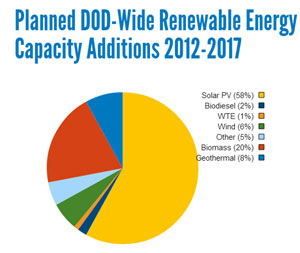The US Air Force cut the ribbon this month on the biggest solar array in the US military so far – a 16.4 megawatt (MW) system at Tucson’s Davis-Monthan Air Force Base.
Covering 170 acres of land, it’s providing about 35% of the power for the base, and is expected to supply 100% during more temperate times of the year.
A 20 MW project for the Army is under construction.
The military is using the same model for renewable energy installations across the US – they are built on military land by private contractors that own and maintain the systems and sell the electricity to the base under long term power purchase agreements.

In exchange, the base saves on energy bills – about $500,000 a year in the first few years – without having to spend a dime on upfront costs.
The same is true for upgrading energy efficiency – they do that through energy saving performance contracts.
By moving to independent, on-site energy, the Department of Defense (DOD) is also getting much more reliable energy. Over the past few years, the military had to deal with 87 day-long power outages across the US, reports Pew.
"This is a win-win-win proposition: The military gets better energy infrastructure, taxpayer dollars are saved, and the clean energy industry is finding new market opportunities," says Phyllis Cuttino at Pew.
Over the past 10 years as the military has been upgrading efficiency and adopting renewables, it has already saved hundreds of millions of dollars on energy bills. Until recently, its annual energy bill has been about $4 billion a year.
And there are lots of these contracts. Last year, the Army announced it had selected 20 suppliers to receive $7 billion in renewable energy contracts, which adds up to an eye-opening 4 GW of projects and a boon for the industry. 15 contracts are for solar, three for wind and two for biomass.
From 2010-2012, the US military nearly doubled renewable energy installations, growing from 454 to 700 projects, according to the report, Power Surge, by Pew Charitable Trusts. Energy efficient projects also rose dramatically from 630 to 1,339 over those three years. Over the last 10 years, the Army has cut energy consumption about 16%.
As of early 2013, over 130 MW of solar PV are supplying energy to bases in at least 31 states and the District of Columbia.
Six Army bases are targeting net- zero energy, six net-zero water and another six net-zero waste.
"Just as steam turbines and nuclear technology changed military calculus in the past, so it is today. Energy efficiency measures are improving the working conditions for our troops by providing improved lighting and more effective heating and cooling technologies. 21st on-site solar, wind, and geothermal technologies and microgrids are helping to ensure that those lights and temperature controls never run out of electricity on our bases," says retired Senator John Warner.
All this has occurred since 2008, when DOD convened a task force to examine the energy challenges facing the military. Their report, "More Fight-Less Fuel," said the military had to face two major challenges: significant and growing demand for fuel in combat operations, and the vulnerability associated with almost complete reliance on the nation’s aging and vulnerable commercial power grid.
The Department of Defense goal is to have 3 GW of renewable energy installed by 2025 – producing 25% of its energy – with each military arm committed to 1 GW of that. At the same time, DOD is reducing energy used per square foot (energy intensity) by 3% a year. It has 550,000 buildings and structures that total 2.3 billion square feet.
The Air Force is working toward using biofuels for 50% of domestic aviation by 2016. The Navy’s goal is to cut fossil fuel use in half by 2020 and is in a partnership to develop advanced biofuels and bioenergy refineries for the US military worldwide.
About 11.5% of DOD’s energy currently comes from renewables.
Read Pew’s report, Power Surge, which is their third report on the military’s clean energy policy:
